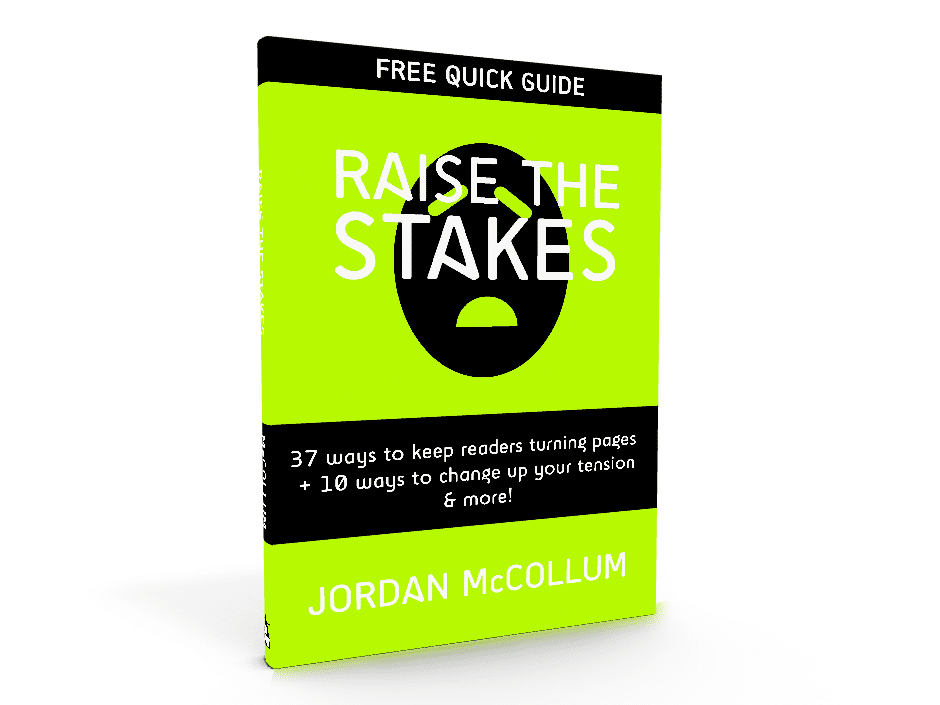If assessing your own tension is hard, critiquing your own suspense level is even harder. But there are a few things we can try to look at objectively to help us find the places where our suspense gets weak. Examining the pacing, the promises and the parallels can point us to places where we need to punch up the suspense.
Pacing
The first place we can look is at the pacing. At Edittorrent, Alicia Rasley once defined pacing as “a measure of how frequently important plot events happen in your story, how closely occurring they are.”
 To examine this, make a list of the 10-20 most important events in your story (things like Plot Point 1, the Climax, the Dark Moment, the Resolution, the Inciting Incident). Then go back to your scene chart and highlight those scenes (note that some of them may take more than one scene). Literally—select the whole row in the spreadsheet or draw a big, fat star on the card with a marker.
To examine this, make a list of the 10-20 most important events in your story (things like Plot Point 1, the Climax, the Dark Moment, the Resolution, the Inciting Incident). Then go back to your scene chart and highlight those scenes (note that some of them may take more than one scene). Literally—select the whole row in the spreadsheet or draw a big, fat star on the card with a marker.
Then look at the whole—zoom out until you can see all the rows on the spreadsheet or layout the cards in order and stand back. Where are the big gaps between important events? That may be a point where the suspense is starting to wear thin—so take a careful look at those long stretches of unhighlightable scenes. Make sure they’re giving the reader something to look forward to, some reason to move on to the next scene—like a promise.
Promises
Promises are key to creating suspense. Suspense is all about anticipation—and when we promise the reader some event, we put them in suspense. You can add another column to your scene chart of promises made in a scene, and another for promises fulfilled. (In the example below, I used lettering to keep track of the promises, and rated the importance/tension of the promise on a scale of 1-10, to make things easier and keep track of the relative importance of the promise.)
| Scene | Promise | Fulfilled |
| 7 | She’ll meet him at dawn (D)—6 | A fulfilled |
| 8 | – | C fulfilled |
| 9 | He’ll kill her (E)—10 | B delayed |
| 10 | – | D fulfilled; E denied |
Note that not every promise we make must be fulfilled in the next scene, or the next time we come to it. In fact, delaying promises, while reiterating that they’re coming and how important they are, is a great way to increase the suspense. (Plus, this handy chart makes sure we don’t forget anything 😉 .)
Those in-between sections from the highlighting exercise can be a great place to look for these (since the important events are probably already setting up and fulfilling a number of promises). So has it been a long time since we’ve seen any promises made, fulfilled, delayed or denied?
Tomorrow, we’ll look at how parallels can show us places to punch up the suspense.
What do you think? How can we look at our pacing? What else can pacing and promises show us?
Photo credit: John Bounds

 But man, when that idea strikes, it’s hard to make myself do the normal day-to-day, keeping-the-house-clean, being-a-mom stuff. All I want to do is write, and yet no matter how fast I write (my record is 5000 words in a day), it’s not fast enough. The rest of the book stretches out in front of me, scenes and lines and snippets that threaten to slip away before I can get there. So I race on.
But man, when that idea strikes, it’s hard to make myself do the normal day-to-day, keeping-the-house-clean, being-a-mom stuff. All I want to do is write, and yet no matter how fast I write (my record is 5000 words in a day), it’s not fast enough. The rest of the book stretches out in front of me, scenes and lines and snippets that threaten to slip away before I can get there. So I race on. For me, that’s stuff I can add later, in each layer of editing. In fact, I’m taking this week off drafting to go back to the first MS I wrote during this year to add in more of those descriptions and sensory information, since the second half of the book is rather bereft of those (silly me, thinking all the character and setting descriptions were established in the first half, and we wouldn’t need anymore after that!).
For me, that’s stuff I can add later, in each layer of editing. In fact, I’m taking this week off drafting to go back to the first MS I wrote during this year to add in more of those descriptions and sensory information, since the second half of the book is rather bereft of those (silly me, thinking all the character and setting descriptions were established in the first half, and we wouldn’t need anymore after that!).

